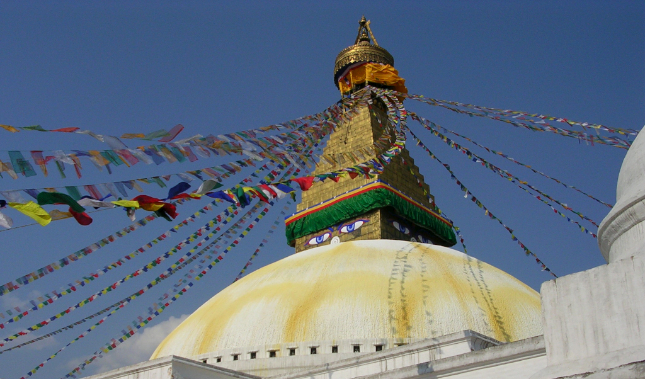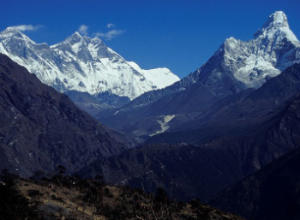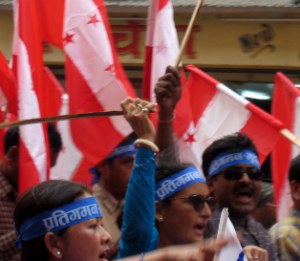Via Nepal, China Gains Foothold in South Asia

This is the tenth in a series of articles that looks at China’s borders. As China has grown in the last 30 years, so have the often complicated relationships it has with its many varied neighbors. In this article, we take a look at Nepal.
By Joyce Roque
“In Buddhism we have relative truth and absolute truth.”
-Dalai Lama
July 25 – Nepal is a country that traces its land at the spine of the great Himalayan mountain range. As a landlocked territory in South Asia, it acts as a buffer state between China to its north and India to its south, east and west. The country is poor but what it lacks in economic riches it makes up with its inspiring scenery and ancient culture.
 Adventurers from all over the world have long been attracted to its beauty and promise of the exotic. Nepal is reputed to have the best hiking trails; eight of the world’s ten highest mountain peaks are within its territory. The highest mountain in the world, Mount Everest, with a summit of 8,848 meters (29,029 feet) above sea level is located at its border with China. It is the only country that has Hinduism as its official religion while also having a non-quadrilateral national flag.
Adventurers from all over the world have long been attracted to its beauty and promise of the exotic. Nepal is reputed to have the best hiking trails; eight of the world’s ten highest mountain peaks are within its territory. The highest mountain in the world, Mount Everest, with a summit of 8,848 meters (29,029 feet) above sea level is located at its border with China. It is the only country that has Hinduism as its official religion while also having a non-quadrilateral national flag.
The country is also important as the birthplace of Buddhism. Prince Siddhartha Gautama, known as the Buddha, was born in the sixth century B.C. Lumbini, now a UNESCO World Heritage Sites. Gautama was then a young price who lived an extravagant sheltered life while his father, Suddhodana, was the ruler of the Sakya people. He began practicing asceticism and later went on to preach The Middle Way. Today. Buddhism is one of the major religions in the world.
Currently, an estimated thirty one percent of the country’s population lives below the poverty line. In 2007, with per capita income was US$386. Agriculture contributes to 38 percent to national GDP as well as being the livelihood for majority. This makes economic growth easily dependent on weather conditions. So it is no surprise that much of industrial activity involves the processing of agricultural produce including jute, sugarcane, tobacco, and grain.
Nepal’s prospects for foreign trade and investment will remain low because of its small market size, lack of technology and infrastructure and isolated geographic location. Tourism, a major source of foreign revenue has been affected due to recent political unrest.
The monarchy ends
The country’s history in the last 20 years could read like a best-selling novel: political intrigue, scandal, massacre and drama at every turn
The Shah dynasty has been ruling the country for the past 250 years. They are not only seen as leaders by Nepalese but also as a living incarnation of the Hindu god, Vishnu, the Preserver of Life. The monarchy was said to have given the country a sense of unity and a link between its past and present, fair play and freedom from petty political concerns.
It would be in 2001 that the monarchy would be dealt its hardest blow. A drunken Crown Prince Dipendra would shock the nation by killing his parents, the King and Queen of Nepal, and seven other royals at a family party before committing suicide. Sources speculate that the prince’s motive came from bitter arguments over his parent’s disapproval for his choice of wife and plans to return to return the country to monarchial rule.
Several days following the tragedy, Gyanendra, one of Birendra’s younger brothers, was crowned king. The tragedy was so scandalous, that many conspiracy theories spread. One popular theory pointed to Gyanendra as the mastermind of the massacre for the obvious reason that he would be the one to benefit the most as the next in line to the throne. Another theory supposes that for its own political reasons, India wanted Nepal’s monarchy to end thus supporting both the royal killings and the Maoist revolution to break the country.
 King Gyanendra’s seven year reign would prove futile; always suffering from the shadow cast by the tragedy. Since then the mercurial state of the country’s politics only worsened. The government would fail to suppress the Communist Party of Nepal-Maoist decade-long civil war against it which was said to have killed 13,000 people.
King Gyanendra’s seven year reign would prove futile; always suffering from the shadow cast by the tragedy. Since then the mercurial state of the country’s politics only worsened. The government would fail to suppress the Communist Party of Nepal-Maoist decade-long civil war against it which was said to have killed 13,000 people.
The fighting between the rebel group and the government would only formally end in April 2008 when the country held elections that saw the Maoists winning majority of the constitutional assembly. The results reflected a nation that had grown jaded of the relevance of the monarchy and hoped for the dream of a better life offered by the Maoists.
The House of Shah would be turned into a museum and King Gyanendra allowed to remain in the country to live as a private citizen.
Following Mao
From a group of guerillas terrorizing the countryside to a legitimate political party that would take 116 seats in the country’s 601-member Constitutional Assembly, the Communist Party of Nepal-Maoist has come a long way. The group was established by Pushpa Kamal Dahal, more known by his war name Prachanda meaning “the fierce one.”
Under his charismatic leadership, Prachanda upheld the teachings of Mao Zedong. The Maoists are fundamentally textbook communists although analysts say that they could become as pragmatic as China but not as rigid.
The Maoist gained support from the poor Nepalese with their call for redistribution of land, extension of power centers into rural areas, elimination of the caste system, equal rights to women and institute a republic.
The Nepalese Maoists are distinct because one third of their army is composed of combat-ready women. In a nation where half of its population are women it is no surprise that they are one of the marginalized groups most eager for change.
In the past, Beijing has rejected links to the Nepalese Maoists saying that the movement has nothing to do with the late Chinese leader Mao Zedong and more so because the Nepalese cause has little resonance among contemporary Chinese leaders.
The country is currently in a state of flux. It remains to be seen if the Maoists can weather the complex political transition to shift their country from a feudal society to a modern, federal republic nation.
Despite recent developments the group is still included in the U.S. Terrorist Exclusion List and the Specially Designated Nationals and Blocked Persons List that bans them from any traveling or owning any property in the United States.
In a recent interview with the Chinese newspaper Nanfang Daily, Prachanda said the economy was a primary concern. “Without economic development, it will be difficult to maintain social stability.” The Chinese model of economic development is an example that Nepal could take inspiration from he said.
China marches to South Asia
It is Prachanda’s vocal stand to be politically equidistant to both China and India that is causing India to worry. Historically, India and Nepal share closer ties both in terms of culture and geography. Some even would go far as saying that Nepal serves as an informal “external part” of India even though it maintains its sovereign jurisdiction.
India is Nepal’s number one export and import market while China ranks as its second import market. For the longest time, India has provided Nepal with extensive aid and training to its army.
Things are about to change as Nepal’s new ruling government wants to renegotiate the terms of the Indo-Nepal Treaty of Peace and Friendship of 1950. The treaty had allowed the free movement of people and goods between the two nations including close collaboration on issues of defense and foreign affairs. Among the Nepalese, the treaty is seen as a breach of its sovereignty.
India has always used its influence with Nepal as a way to deflect its regional competitor, China. The nation lies at the foot of India’s door and divides the two giant emerging economies from each other.
China may also want to increase its clout over Nepal so as not to encourage any more separatist movements coming from Tibet, which is also close to the nation. Presently, around 20,000 Tibetan exiles now live in Nepal.
In July 2008, Nepal’s Supreme Court released three senior Tibetan refugee officials arrested in Katmandu and charged with chanting and organizing anti-China demonstrations in response to the Chinese crackdown in Tibet last March.
According to an interview by Kantipur Report, Wang Hong-wei, an expert on Nepal policy at the Institute of Asia-Pacific Studies in Beijing said that, “China knows very well that India wants to turn Nepal into a second Bhutan or Sikkim. Moreover, Nepal may enter the process of “Sikkim-ization.” But, China must not let this situation occur. China will always lend its support to keep Nepal sovereign, free and united.”
Sikkim was then a small kingdom that was eventually included into the Indian Union in 1975. China had previously claimed the territory as part of Tibet thus a part of China.It is located in the Himalayas and borders Nepal in the west, Tibet to the north and east, and Bhutan in the southeast.
China is also looking at Nepal as a source of profitable hydropower deals from its glacial lake. By 2010, the upgraded China-Nepal Highway should be completed to connect China’s Lhasa with Nepal and eventually the rest of South Asia at a total investment cost of RMB800 million (about US$100 million).
A larger look at the region will show that China is not limiting its play for influence to Nepal. It is also looking to increase its contribution to the economies of India’s other neighbors namely Bangladesh, Pakistan and Sri-Lanka by way of infrastructural development and financial grants.
In the end, Nepal is only a part of China’s plan to slowly make its way into the realm of India’s sphere of influence by serving as a counterbalance to its growing economic and military power in the region.
This is the tenth in a continuing series that focuses on China’s borders. The complete series to date can be found here.
- Previous Article Taking Advantage of Beilun Port: The Ningbo Economic and Technical Development Zone
- Next Article Top China SOEs to Restructure After Games









